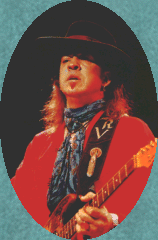

Stevie Ray Vaughan
October 3, 1954 - August 27, 1990
Birthplace: Dallas, Texas
No artist did more to
energize the 1980s blues revival than Stevie Ray Vaughan. He was a guitar player whose
style echoed the dazzling technique of Jimi Hendrix as much as the virtuosity of blues
greats from the Texas and Chicago schools. Vaughan ignited new interest in the blues at a
time when longtime fans of the music were relying on old blues legends for their fix, and
rock audiences had all but annulled the blues-rock marriage of the late '60s.
Vaughan cultivated a new passion for the blues mostly through his riveting live
performances, which bristled with guitar power and blues excitement. By playing loud and
paying his respects to Hendrix, Vaughan attracted rock listeners to his concerts. But his
essential repertoire was the blues. His highly charged, emotionally expressive guitar
solos gave the blues a brand-new vitality and reinvented the music in thoroughly modern
terms.
Vaughan was born and raised in the Oak Cliff section of Dallas; from the start his main
inspiration was his older brother, Jimmie, who introduced him to both the guitar and the
blues. As a youth in Dallas, Stevie Ray played in blues-rock bands such as the Chantones
and the Blackbirds. But when brother Jimmie, who later would become the guitar player in
the Austin-based rhythm & blues group the Fabulous Thunderbirds, left home in his
teens to pursue a career in music, Stevie Ray was inspired to do the same. He quit high
school at the end of his junior year and moved to Austin, where he joined the Cobras in
1975. Two years later he formed the Triple Threat Revue with blues-rock singer Lou Ann
Barton. The group played blues and R&B in Austin bars and roadhouses. In 1978 Triple
Threat became Double Trouble. (Vaughan named his new group after the Otis Rush song by the
same name.) Eventually the band would consist of bass player Tommy Shannon, who in the
late '60s had played with Johnny Winter, and drummer Chris Layton. Vaughan assumed all the
guitar and vocal chores. Except for the addition of keyboards player Reese Wynans in 1985,
the lineup remained constant until Vaughan's death in 1990.
Double Trouble quickly established itself as one of Austin's best bar bands. When manager
Chesley Milliken gave friend Mick Jagger a videotape of one of Double Trouble's live
performances, the Rolling Stones singer was so impressed that he hired the band to play a
private party in New York in 1982. That same year producer Jerry Wexler saw Double Trouble
perform in Austin and was so moved by Vaughan's scintillating guitar work that he arranged
for Double Trouble to play the 1982 Montreux Jazz Festival in Switzerland, reputedly
marking the first time an unrecorded group or artist had played the prestigious fest. Rock
singer David Bowie and folk-rock artist Jackson Browne were both in the Montreux audience
the night Double Trouble performed. Equally impressed, Bowie hired Vaughan to play on his
Let's Dance album, while Browne offered Vaughan and his band free recording time in his
California studio. Shortly thereafter, legendary talent scout John Hammond, Sr., convinced
Epic Records to sign Vaughan and Double Trouble to a recording contract. The band recorded
its classic debut album, Texas Flood, in less than one week at Brown's Down Town studio in
L.A. Critically acclaimed, the album showcased Vaughan's stunning guitar work and
resurrected the blues at a time when the rest of pop music seemed infatuated with
British-dominated techno dance-rock.
Texas Flood was nominated for two Grammys in 1984-best traditional blues recording and
best rock instrumental (for the song "Rude Mood' ')-while the readers of Guitar
Player magazine named Texas Flood blues album of the year and Vaughan best new talent and
best electric blues player in 1983 and 1984. (Vaughan would also win the latter title in
1985, 1986, 1988, and 1989.)
Vaughan followed up Texas Flood with another acclaimed album, Couldn't Stand the Weather,
which contained Vaughan's widely hailed interpretation of the Hendrix classic "Voodoo
Chile (Slight Return)," in 1984, and Soul to Soul, an album on which Vaughan delved a
bit into jazz and added the keyboards of Reese Wynans. During this time Vaughan was also
pushing himself to the limit with drugs and alcohol; in 1986 he collapsed onstage in
London. Vaughan then entered a rehabilitation clinic and kept a quiet profile until the
release of In Step in 1989, his last official studio album, which included the song
"Wall of Denial," a painful autobiographical account of his battle with drugs
and alcohol.
Long overdue was a much-hoped-for album with brother Jimmie. In 1990, the Vaughan brothers
recorded Family Style, a work that produced such hits as "Tick Tock" ( 115 k, 10
sec.) and hinted of a new musical direction for Stevie Ray Vaughan and the possible
partnership of the two musicians in future recording projects. Shortly before the release
of Family Style, Vaughan performed with Buddy Guy, Eric Clapton, Robert Cray, and brother
Jimmie at an East Troy, Wisconsin, blues concert. Eager to get to Chicago, Vaughan hopped
onto a helicopter immediately after the show. In dense fog, the copter crashed, killing
everyone aboard. Vaughan was thirty-five years old. Family Style was released
posthumously, as was The Sky Is Crying, a collection of previously un-issued songs, and In
the Beginning, a live recording from 1980.
"Tick Tock" is from The Vaughan Brothers - Family Style Copyright © CBS Records
Inc., 1990.